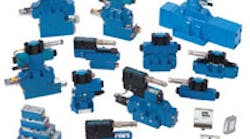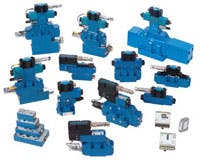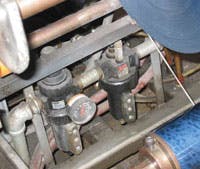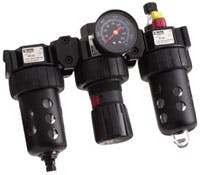New technology impacts every one of us daily, whether we realize it or not. It may be a higher frequency scanner at the self-checkout line in the grocery store or an automated camera at a traffic signal that takes a picture of your license plate without you knowing and then mails you a ticket. Some technologies can reap great rewards toward improving the efficiency of your operation, but finding the right balance of features you really need with the cost of new technology can be a challenge.
Change can mean savings
Sometimes the reward of improved operating efficiencies and increased profitability can be found in a seemingly unrelated source. Productivity improvements are obvious, but energy efficiency gains and improved cycle times can be more difficult to achieve. If your fluid power system was designed with 1970s technology, upgrading to new, dynamic technology can yield unexpected benefits that will impact your company’s bottom line.
All hydraulic system components leak internally to some extent. This is a good because that internal leakage helps to lubricate all of the moving parts and keep them cool. The down side is any internal leakage that does not produce work in the system escapes as heat. An inefficient system can run very hot and break down the properties of the hydraulic fluid. An intangible effect is operator discomfort and possible injury. Some systems use large heat exchangers to mask the heat generation.
The real savings in upgrading to more efficient hydraulic components can be measured in three places, including:
- the energy savings to actually drive the pump. A more efficient system requires less flow to be produced to do the same job, thus reducing the input horsepower requirement.
- the reduction or elimination of the heat exchanger. A normal system will dissipate some heat, and running even a small horsepower motor on the heat exchanger for an entire shift adds dollars to the electric bill.
- the life of the hydraulic fluid. The direct impact is the real dollars spent on changing the oil, while an intangible impact is supporting new green initiatives. Less used oil is obviously better for the environment.
Select for full image
Gear pumps vs. piston pumps
At the beginning of every hydraulic system is a pump. Pumps have come a long way in the past 30 years, with the most dramatic improvements coming in the last five years. Back in the days of the leisure suit, hydraulic gear pumps were typically used as a source of power in hydraulic systems, and many of those old, inefficient pumps are still running today. A gear pump with a little bit of internal wear could be running at 70% efficiency. Although 70% is still a passing grade in most schools, the thought of losing 30% of the energy just to drive the pump can make a big impact on your electric bill. New piston pumps operate at 95% efficiency and typically provide a return on investment of less than one year.
While your energy costs may vary, the numbers in Table 1 are representative of the cost savings associated with today’s higher-efficiency pumps.
Pipe fittings are easy to install the first time but difficult to replace and can have many leak points.
Obviously, moving from an old technology pump to a newer, more efficient design can gain some very tangible rewards. These newer technology pumps also reduce the noise produced. Ever try and have a quiet conversation next to an old hydraulic system? Do you have a power unit tucked away in a back room just to keep your plant quieter for the equipment operators?
Turn off the switches
Look at the control side of your fluid power system when looking for cost efficiency gains. How many mechanical limit switches, air gap sensors, and old directional valves do you have still in use today? Vast improvements have been made in hydraulic control systems. Although you may see some minor improvements in efficiency of the overall system, the true gold to be mined is in system uptime, reliability, consistency, and faster cycle times.
If your hydraulic system still uses limit switches, you’ll know it was designed in the disco era. Typical applications include a cylinder that needs to extend fairly quickly for most of the stroke, then slow down the last few inches, and finally stop. In the past, we would have used one limit switch to start the slow down process and a second limit switch to actually make the stop. What we typically find is the first switch ramps down very quickly and time is wasted during this portion of the cycle.
Proportional valves increase efficiency
Proportional valves are a better option for improving efficiencies in this type of application. Although they have been on the market since the disco era, recent improvements in technology have made proportional valves a good cost-reducing investment.
The challenge with earlier models was that they were more difficult to set up than the clock on a VCR. Today’s user interface controls and on-board electronics have made these devices ready for production with virtually no frustration.
Proportional valves also offer the added benefit of allowing you to simply replace the old limit switches with a non-contact sensor and add a little wiring, thus improving cycle time by fine tuning the speeds of the system. More parts coming off the assembly line with more consistent quality means more revenue produced. Tie this all together with a much simpler Programmable Logic Control (PLC), and you have several options to streamline production run changeovers. No more spending days setting up and calibrating a system to produce 12-in. widgets after running a batch of 34-in. widgets.
Eliminate lubrication
Using pneumatic valves and cylinders that do not require additional lubrication offer another significant improvement over previous technologies. In the past, air systems had a filter, regulator, and lubricator. You took extra care when you first set up the system to make sure the lubricator was full, then you took a guess at how much oil the lubricator would mist into the air stream. A little extra oil was generally thought to be better than not enough. If you actually maintained the oil in the lubricator — which most people forget to do — think about how much oil was misted through the air system and back out into the air in the production facility. Not only is this an environmental issue for the operators, but it also produces a film of oil on everything in the plant, including the quality product you are making.
Most new valves and cylinders do not require any additional lubrication, yet can run for millions of cycles. In fact, most manufacturers state that additional lubrication will actually shorten the life of the component because it washes away the lubrication that was provided during the component manufacturing process.
Take a close look at the basics
A quick stroll through your plant can deliver big savings to the bottom line. Look for any component or system that is running hot. Before you add a bigger heat exchanger, ask yourself, is there a more efficient way to do this? Look at the individual hydraulic and pneumatic components, and especially check the age of the technology being used. If you have replaced a pump on a system more than twice in the last ten years, it’s time to reassess the system. The next time you order a mechanical limit switch, walk out on the plant floor and ask yourself, is there a better way to solve this problem? The disco era was great — but it’s time to move on; today’s technology is far more dynamic and will give your company greater productivity and profits.
Tom Nash is hydraulic product manager at Applied Industrial Technologies. For more information, email [email protected], call (216) 426-4257, or visit www.applied.com






